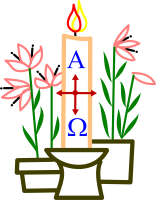
The Paschal Candle will remain here until Pentecost, in the same way that it will be lit at all services in church during this period. One of the many symbolisms of the candle is that of the presence of the Risen Christ on earth among His disciples, and before His ascension into heaven.
Christ is Risen – Alleluia, Alleluia!
He is risen indeed – Alleluia, Alleluia!


